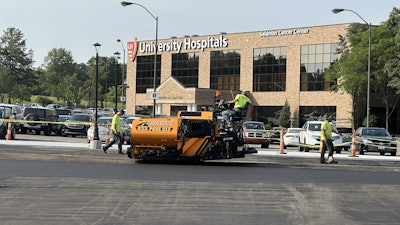
Hospitals need a lot of parking space, and not just for patients. To safely operate a hospital, it requires hundreds of support staff on-site, at all times of the day and through the night. It never closes. There's a constant stream of doctors, nurses, aids, custodians, cafeteria, pharmacy, and other office workers. When you're the only hospital for a whole county, like University Hospitals Portage Medical Center (Ravenna, OH), active parking needs can fluctuate rapidly, hour-by-hour.
UH Portage houses many offices for patient visits, a twenty-four hour emergency room, and the county's only cardiac cath lab that responds to heart attack patients any-time, any-day of the year. Yes, even on Christmas. This location serves as the primary medical facility for the more than 162,000 residents whole live in Portage County. All this adds up to an enormous amount of wear-and-tear on the blacktop parking surfaces, as vehicles are constantly coming and going, and the Northeast Ohio seasonal weather changes compound on top if it all.
When a client this busy needs to the inevitable maintenance work done, the most important factor of all is planning. Additionally, the incorporation of data from the hospital, as it concerns daily capacity patterns, are essential to the phasing plan process. Since nothing can shut-down, shifting the usage zone-by-zone, is the only way to get things done in a safe and efficient manner, just as on any commercial jobsite, but with a hospital client, there are many additional factors and concerns.
A Large Community Investment
Brian Adams is the Director of Operations and Clinical Services at UH Portage, and this project, an investment of $1.2 million, is the first maintenance initiative of this scale during his tenure.
"We've been doing a lot of repairs, but we got to the point where repairs were no longer adequate. We really needed to put in a large scale paving project," Adams said. "As part of the University Hospitals Health System, we work with the folks who oversee Capital Asset Management Program (CAMP) for all of our campuses, which is more than a dozen hospitals and probably a couple hundred health centers and offices all over Northeast Ohio, across nine counties. That's a lot of property."
The CAMP has a specific allotment of resources every fiscal year, and they are tasked with prioritizing what projects will receive those funds at what locations across the network.
"People from the CAMP group saw that our parking lot had some pretty serious needs," he said. "We are the only hospital in the county, so we're taking care of a lot of people. So we have a lot of people coming into our doors for emergency care, inpatient care, regular doctor's office visits, imaging, and many other services."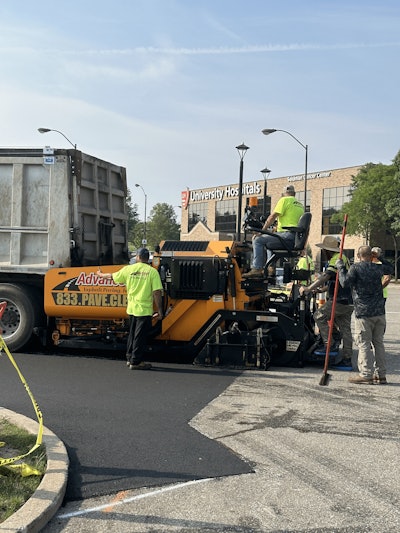
The cardiac care that people can get at UHPMC also drives extra traffic from neighboring counties, because the next closest hospital that has a cath lab for heart attacks is another half hour drive away in the city of Akron. Unsurprisingly, the hospital's number one priority is patient safety, and it was determined that the extent of work that needed done in the parking areas was needed in order to avoid any possible falls, trips, or other injuries related to pavement liabilities.
"It does improve the aesthetics of our campus, but it's definitely a safety issue first-and-foremost," Adams explained. "It goes beyond even our patients. We are one of the three major hubs for PARTA, which is our county public transportation. So, a couple dozen buses every day go through our campus. This is a point of transfer for many local residents, and their safety is important to us, as well."
Who Is Going To Do The Work?
For a job with such a large budget, and with so many complex factors in-play, selecting the right contractor is vitally important. The hospital is trusting the contractor to do more than just lay good mat. As the phasing process unfolds, proper traffic management, worksite safety, efficiency, as well as interacting and protecting people around the work areas, are all major components in what the hospital has to consider in a potential contractor. For UHPMC, one contractor in particular met all their needs, and more.
Advanced Asphalt Paving first worked on a project with University Hospitals back in the mid 1990s. Dave Martin bought the company from his father Jeff Martin, who was running things at the time.
"We were called on to a project by the hospital after the original contractor hired for some work had trouble managing the job and keeping the hospital accessible at the same time," said Ken Lengyel, VP of Sales. "We put together the basic protocol for how to approach these large scale paving jobs while meeting their obligations to the public. They awarded us the first few locations after than, and we've been doing work for them ever since."
Part of their strategy involves breaking the work down into phases or zones that can be completed in a twenty-four hour period. On many jobsites, it's normal that all the required milling will be completed first, then it's cleaned and tacked. After that, all the paving work is completed, and lastly, the new striping is completed. When doing work for the hospital, each phase must completed every one of these steps in a single day.
"Our crew is a little heavier than the typical paving crew, that's part of our sales pitch," said Martin. "We can take out and put back in a parking lot in one day rather than most companies who have a milling crew that will come out and mill it one day and then they're paving crew will chase behind and pave it another day. We don't have that two day disruption."
Communication is Key
For this job, there were twenty-two individual zones. Starting from a simple Google Maps satellite image, the work is divided up carefully.
"Advanced Asphalt Paving did the survey work and figured out where the most critical areas were," said Adams. "Then we sat down and discussed the risk areas of shutting down? What can we not shut down at the same time? They understood how much ground they could cover in a day. We had to work through their logistics and then our logistics of safety of the campus and made sure we have access and ease for our patients."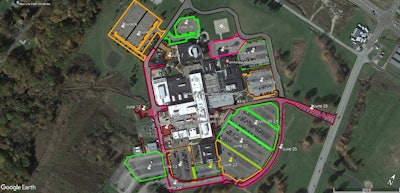
This accomplishes a couple things simultaneously, not the least of which is that the hospital administration can know exactly which parts of the parking lot will be closed off on which days. They can accurately guide patients to the most accessible entrances, mark alternative paths, and ensure that inbound emergency vehicles are properly notified.
"There are potentially thirty-to-forty different communities and private ambulance services that bring patients here," Adams explained. "Signage is very important. Advance notice is very important. Real time communication is key to let everyone know which entrance or area is closed at any given time."
Just such a scenario took place when the hospital's helipad was needed, on the same evening the crew was doing maintenance on it.
"We were in constant communication with the hospital," Lengyel said. "One night in particular, we had to shutdown operations for more than an hour when they had a life-flight situation involving a child, and we were working up to the last possible second."
"There was a young person in critical need of an advanced level of pediatric care," said Adams. "We knew the helicopter was coming in about 15 minutes. We gave the paving crew a warning. They told us to let them know just before they needed to stop, and so we gave them la two minute warning. Somehow, they stopped everything and moved it out of the way just as the helicopter arrived. That person to got the care they needed as quickly as possible, because of their coordination."
"We were still able to complete that section and have it open the next day, despite the loss in work time," said Martin.
The importance of multi-phase planning on large pavement jobs is always an important part of the work our industry does. However, the difference between the weekend warrior and the true professional, is how thoroughly they utilize tools and strategies in complex working situations. It isn't always a matter of life-and-death, but, as Dave Martin pointed out, it's important on every jobsite you step onto.
"All of our project managers and crews are trained to limit disruptions as much as possible," he said. "Whether it's a gas station, a shopping center, or a hospital we're a customer first organization, whether it's ambulances and helicopters or someone coming in for their morning coffee."
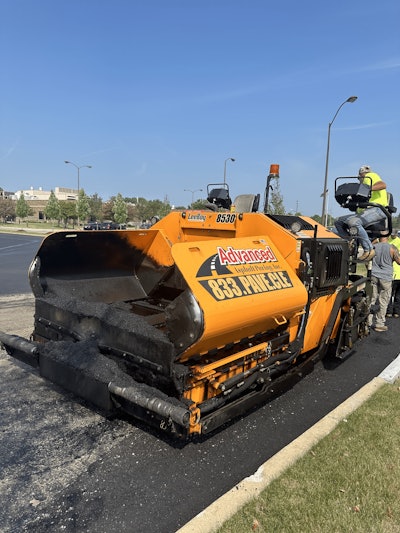






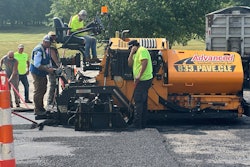
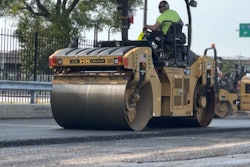




![Lee Boy Facility 2025 17 Use[16]](https://img.forconstructionpros.com/mindful/acbm/workspaces/default/uploads/2025/09/leeboy-facility-2025-17-use16.AbONDzEzbV.jpg?ar=16%3A9&auto=format%2Ccompress&fit=crop&h=135&q=70&w=240)








